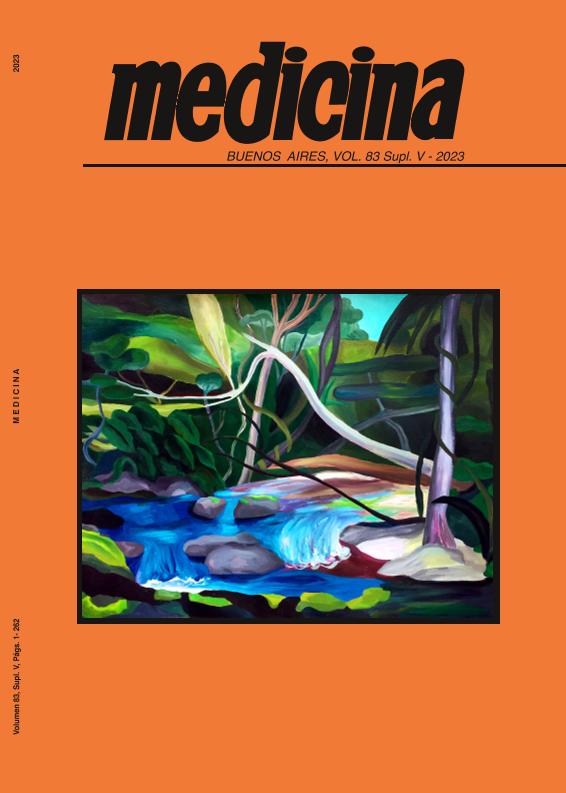Evento
Sphingosine-1-phosphate signaling is essential for preserving morphology and focal adhesions of retina pigment epithelial cells
Torlaschi, Camila; Gutierrez Jofré, Gabriela Mabel ; Rotstein, Nora Patricia
; Rotstein, Nora Patricia ; Simon, Maria Victoria
; Simon, Maria Victoria
 ; Rotstein, Nora Patricia
; Rotstein, Nora Patricia ; Simon, Maria Victoria
; Simon, Maria Victoria
Tipo del evento:
Reunión
Nombre del evento:
LXVIII Reunión Anual de la Sociedad Argentina de Investigación Clínica; XXV Jornadas Anuales de la Sociedad Argentina de Biología; LV Reunión Anual de la Asociación Argentina de Farmacología Experimental y VIII Reunión Científica Regional de la Asociación Argentina de Ciencia y Tecnología de Animales de Laboratorio
Fecha del evento:
15/11/2023
Institución Organizadora:
Sociedad Argentina de Investigación Clínica;
Sociedad Argentina de Biología;
Asociación Argentina de Farmacología Experimental;
Asociación Argentina de Ciencia y Tecnología de Animales de Laboratorio;
Título de la revista:
Medicina (Buenos Aires)
Editorial:
Fundación Revista Medicina
ISSN:
0025-7680
e-ISSN:
1669-9106
Idioma:
Inglés
Clasificación temática:
Resumen
Cell-cell interactions between retinal pigment epithelium (RPE) cells provide the retina with a physical and metabolic barrier, the disruption of which characterizes many inflammatory and prolifer- ative retinopathies. However, the underlying causes of this disrup- tion are still ill-defined. We showed that the bioactive sphingolipids sphingosine-1-phosphate (S1P) and ceramide-1-phosphate (C1P) promote migration and inflammation in RPE cells. Using the human RPE cell line ARPE-19, we now analyzed whether S1P regulates cell morphology and RPE monolayer integrity. Inhibiting S1P synthe- sis with PF543, a sphingosine kinase 1 (SphK1) inhibitor, markedly decreased ARPE-19 cell migration in confluent cultures, without af- fecting cell survival. Using 50% confluent cultures, to better observe morphological changes, we determined that PF543 treatment pro- moted a remarkable cell retraction; highly elongated cells, absent in controls, augmented to 34±2% (p>0.01), their cell length/width ratio increasing to 5.3, from 1.6 in controls. S1P addition, 1 h af- ter PF543 treatment, restored cell morphology, reducing elongated cells to 8±1.4% (p>0.01), suggesting that S1P inside-out signaling is required for preserving cell morphology. In contrast, C1P addi- tion did not restore cell morphology in PF543-treated cells. When we preincubated cells with PF543 and JTE-013, a S1P2 receptor (S1P2) antagonist, before S1P addition, JTE-013 partially blocked S1P restoration of cell morphology. To analyze the mechanisms involved in cell adhesion, we determined distribution of paxillin, a scaffold protein in focal adhesions. While controls showed spot-like paxillin clusters in the cell periphery, these clusters disappeared in PF543-treated cells and were restored after S1P addition. These results suggest that inhibiting S1P synthesis leads to morphological changes and focal adhesion remodeling, and activation of the S1P/ S1P2 axis is required for preserving cell morphology and establish- ing focal adhesions.
Archivos asociados
Licencia
Identificadores
Colecciones
Eventos(INIBIBB)
Eventos de INST.DE INVEST.BIOQUIMICAS BAHIA BLANCA (I)
Eventos de INST.DE INVEST.BIOQUIMICAS BAHIA BLANCA (I)
Citación
Sphingosine-1-phosphate signaling is essential for preserving morphology and focal adhesions of retina pigment epithelial cells; LXVIII Reunión Anual de la Sociedad Argentina de Investigación Clínica; XXV Jornadas Anuales de la Sociedad Argentina de Biología; LV Reunión Anual de la Asociación Argentina de Farmacología Experimental y VIII Reunión Científica Regional de la Asociación Argentina de Ciencia y Tecnología de Animales de Laboratorio; Mar del Plata; Argentina; 2023; 151-151
Compartir



